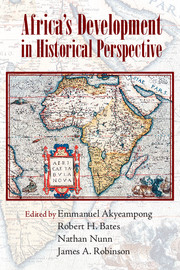Book contents
- Frontmatter
- Contents
- Author Biographies
- Acknowledgments
- Introduction
- Part I La Longue Durée
- 1 Africa in World History before ca. 1440
- 2 Reversal of Fortune and Socioeconomic Development in the Atlantic World
- 3 The Impact of Malaria on African Development over the Longue Durée
- 4 African Population, 1650–2000: Comparisons and Implications of New Estimates
- Part II Culture, Entrepreneurship, and Development
- Part III Institutions
- Part IV External Forces
- Index
- References
3 - The Impact of Malaria on African Development over the Longue Durée
Published online by Cambridge University Press: 05 September 2014
- Frontmatter
- Contents
- Author Biographies
- Acknowledgments
- Introduction
- Part I La Longue Durée
- 1 Africa in World History before ca. 1440
- 2 Reversal of Fortune and Socioeconomic Development in the Atlantic World
- 3 The Impact of Malaria on African Development over the Longue Durée
- 4 African Population, 1650–2000: Comparisons and Implications of New Estimates
- Part II Culture, Entrepreneurship, and Development
- Part III Institutions
- Part IV External Forces
- Index
- References
Summary
An extensive literature examines the impact of disease generally, and malaria in particular, on economic development in the world today. Malaria is especially a focus in Africa because of the high prevalence of the disease. There are some 300 million malaria cases annually on the continent, and it is the leading cause of under-five mortality. A widely quoted estimate is that malaria reduces growth of GDP per capita by 1.3% per year in the African countries most afflicted (Gallup and Sachs, 2001). Africa is also the historical home of malaria, and the region with a physical environment most supportive of the disease.
In this chapter, I ask how malaria influenced economic development in Africa in the period before European contact. In particular, I ask whether malaria played a role in holding back African development and whether malaria shaped the geographic pattern of development. Knowing the role of malaria is part of the much larger project of understanding the determinants for Africa’s early development in comparison to other parts of the world and also understanding heterogeneity within the continent itself.
- Type
- Chapter
- Information
- Africa's Development in Historical Perspective , pp. 89 - 130Publisher: Cambridge University PressPrint publication year: 2014
References
- 2
- Cited by



